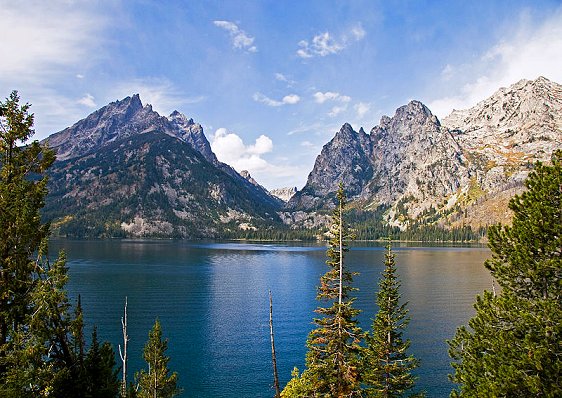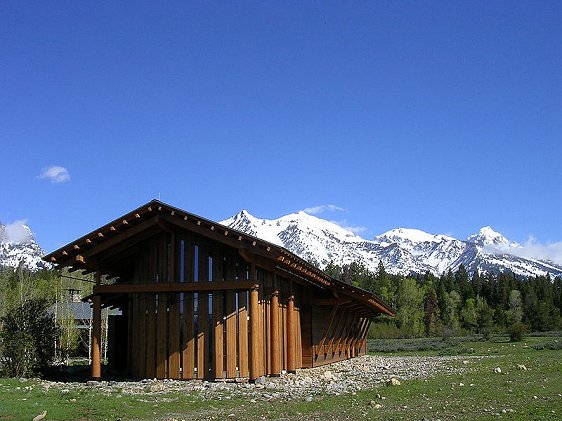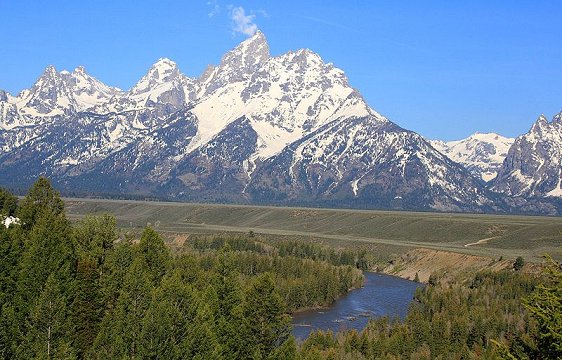
 Grand Teton National Park, Wyoming
Grand Teton National Park, Wyoming http://commons.wikimedia.org/wiki/File:Grandtetonnational_park59887215.jpg
http://commons.wikimedia.org/wiki/File:Grandtetonnational_park59887215.jpg Chascar
Chascar
Grand Teton National Park is a national park in northwestern Wyoming. It was named after 13,770-ft (4,197-m) Grand Teton, the tallest mountain in the Teton Range within the park. Grand Teton National Park covers 484 sq mi (1,250 sq km) encompassing land and water. It was established on 26 February, 1929. The park is located to the south of Yellowstone National Park.
The Teton Range is part of the Rocky Mountains. It starts from Jackson Hole, a 55-mile long valley with a width ranging from 6 miles (9.7 km) to 13 miles (21 km) with an average elevation of 6,800 ft (2,100 m). The Teton Range has eight peaks reaching 12,000 ft (3,658 m). Seven of these form the picturesque Cathedral Group.
 Jenny Lake and Cascade Canyon at Grand Teton National Park
Jenny Lake and Cascade Canyon at Grand Teton National Park http://commons.wikimedia.org/wiki/File:Jenny_Lake_Cascade_Canyon_GTNP1.jpg
http://commons.wikimedia.org/wiki/File:Jenny_Lake_Cascade_Canyon_GTNP1.jpg Acroterion
Acroterion
Evidence of human activity in the Grand Teton National Park area goes back 12,000 years, with the discovery of obsidian used by Stone Age cultures to produce blads and arrowheads. Ancient trade routes and hunting trails traverse the area, through the Teton pass at the southern end of the range, crisscrossing Jackson Hole.
The name Grand Teton may have been named in the 19th century, when French explorers called the three highest peaks Les Trois Tetons, meaning "the three nipples". Fur trappers and fur traders call the deep valleys bordered by soaring mountains "holes". Jackson Hole was named after a fur trapper David Jackson in 1829.
The first white American to arrive in the Jackson Hole area was John Colter, a member of the Lewis and Clark Expedition, in 1805-06. Geologist F.V. Hayden visited it in 1860. In 1871 geologist James Stevenson went there on a government-sponsored scientific survey, as part of a team to the Yellowstone area led by Hayden.
 Willow Flats, Grand Teton National Park
Willow Flats, Grand Teton National Park http://commons.wikimedia.org/wiki/File:Willow_Flats_area_and_Teton_Range_in_Grand_Teton_National_Park.jpg
http://commons.wikimedia.org/wiki/File:Willow_Flats_area_and_Teton_Range_in_Grand_Teton_National_Park.jpg Michael Gäbler
Michael Gäbler
Effort to turn the Teton National Forest into a national park goes back to 1927. Imminent philanthropist John D. Rockefeller quietly began buying up land in the area, with the intention of turinging it to the National Park Service as protected forest land. However the effort to establish a national park face a rocky journey, hampered by opposition from resident ranchers.
On 13 March, 1943, President Franklin D. Roosevelt proclaimed a 221,000-acre Jackson Hole National Monument. The proclamation was followed by further local opposition and campaign to have the monument abolished, from ranchers concerned over their lost of income and livelihood.
 Laurance S. Rockefeller Preserve visitor center, Grand Teton National Park
Laurance S. Rockefeller Preserve visitor center, Grand Teton National Park http://commons.wikimedia.org/wiki/File:LSR-Preserve-02.jpg
http://commons.wikimedia.org/wiki/File:LSR-Preserve-02.jpg Eoghanacht
Eoghanacht
Local attitudes began to change following the end of World War II, when tourism to Grand Teton provided a new source of income for the local economy. On 16 December, 1949, the Rockefeller lands were finally added to the national monument.
On 14 September, 1950, most of Jackson Hole National Monument, except its southern extent, was made the Grand Teton National Park. Thbe highway from the northern border of the park to Yellowstone National Park was named the John D. Rockefeller, Jr. Memorial Parkway, in recognition of the philanthropist's contribution. In 2001, the Rockefellers donated their Jackson Hole retreat to the national park, and it was established as the Laurance S. Rockefeller Preserved which was dedicated on 21 June, 2008.
 Grand Teton, as seen from Snake River Overlook
Grand Teton, as seen from Snake River Overlook http://commons.wikimedia.org/wiki/File:Grand_Teton_from_the_Snake_River_Overlook.jpg
http://commons.wikimedia.org/wiki/File:Grand_Teton_from_the_Snake_River_Overlook.jpg Frank Kovalchek
Frank Kovalchek
Visiting Grand Teton National Park, Wyoming
If you're coming from Salt Lake City, take the Interstate 15 north to Idaho Falls. From there, continue on US Highway 26 to Swan Valley, then Idaho State Route 31 to Pine Creek Pass and on to Victor. Continue on Utah State Route 33 south. It becomes the Wyoming State Route 22 after the state border, over Teton Pass through Wilson to Jackson.An alternative route from Salt Lake City is to take Interstate 80 to Evanston. Continue of Wyoming State Route 89 north. It continues in Utah as State Route 16 through Woodruff, then Randolph. From Highway 16, continue on Highway 30 eastwards. Crossing the Wyoming border, it continues as Wyoming Highway 89. Continue north on US Highway 30, pass Cokeville, then Border. Continue on US Highway 89 east and north to Afton, then Alpine Junction, then Hoback Junction and finally to Jackson.
 Mount Moran from Jackson Lake, Grand Teton National Park
Mount Moran from Jackson Lake, Grand Teton National Park http://commons.wikimedia.org/wiki/File:Moran_Teton_from_north_GTNP1.jpg
http://commons.wikimedia.org/wiki/File:Moran_Teton_from_north_GTNP1.jpg Acroterion
Acroterion
If you are coming from Denver, take the Interstate 25N to Cheyenne in Wyoming. Continue on I-80W to Rock Spring. Continue on US Highway 191/189 to Hoback Junction and onwards to Jackson.
There are a number of visitor centers namely the Colter Bay Visitor Center & Indian Arts Museum, Flagg Ranch Information Station, Jenny Lake Visitor Center, Craig Thomas Discovery & Visitor Center, Laurance S. Rockefeller Center and Jenny Lake Ranger Station. The main one, Colter Bay Visitor Center & Indian Arts Museum (phone 307-739-3399) is open from 8 May to 6 June from 8:00 am to 5:00 pm, 7 June to 6 September from 8:00 am to 7:00 pm, and from 7 September to 11 October from 8:00 am to 5:00 pm.
Vehicle permits to Grand Teton National Park is $25 for 7 days, inclusive driver of non-commercial vehicle and passengers. Hikers and bicyclist pay $12 per person while motorcyle permits are $20 per vehicle.
List of National Parks in the United States
 Latest updates on Penang Travel Tips
Latest updates on Penang Travel Tips
About this website

Dear visitor, thank you so much for reading this page. My name is Timothy Tye and my hobby is to find out about places, write about them and share the information with you on this website. I have been writing this site since 5 January 2003. Originally (from 2003 until 2009, the site was called AsiaExplorers. I changed the name to Penang Travel Tips in 2009, even though I describe more than just Penang but everywhere I go (I often need to tell people that "Penang Travel Tips" is not just information about Penang, but information written in Penang), especially places in Malaysia and Singapore, and in all the years since 2003, I have described over 20,000 places.
While I try my best to provide you information as accurate as I can get it to be, I do apologize for any errors and for outdated information which I am unaware. Nevertheless, I hope that what I have described here will be useful to you.
To get to know me better, do follow me on Facebook!
Copyright © 2003-2025 Timothy Tye. All Rights Reserved.

 Go Back
Go Back